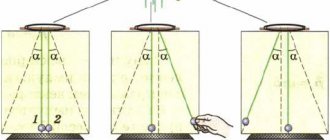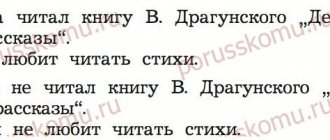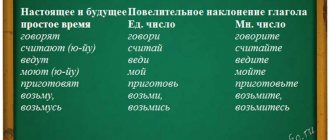Lesson summary “Law of conservation of momentum and mechanical energy” in physics for grade 9
Physics lesson in 9th grade
"Law of conservation of momentum and mechanical energy"
Preparation for the State Examination"
Goals and objectives of the lesson:
— systematize students’ knowledge on this topic;
— solving standard problems on the topic in accordance with the assignments of the State Academy of Sciences;
— contribute to the successful passing of the State Examination;
— develop mutual respect and the ability to work in a team;
- cultivate a friendly attitude towards each other, respect for the opinions of others,
listening skills;
Lesson type: general lesson, problem solving
Equipment used: computer, interactive whiteboard;
During the classes:
1. Organizational stage:
State the topic and purpose of the lesson. Slide No. 1
2. Updating knowledge (repetition of studied material). Slide No. 2:
1. What is called the impulse of a body?
2. What are the units of measurement for this physical quantity?
3. Which system is called closed?
4. How does an absolutely elastic impact differ from an absolutely inelastic impact?
5. Formulate the law of conservation of momentum.
6. What is kinetic and potential energy called and how is it calculated?
7. What is called total mechanical energy?
8. Formulate the law of conservation of mechanical energy.
3. Problem solving:
Using the interactive whiteboard, you can check your answers and solutions to problems.
1) Work in groups. (Students are divided into 5 groups and independently solve the problems proposed on the slide, and also receive cards with the corresponding tasks). Slide No. 4
1) Group 1: The speed of the body increased 3 times. How many times did the kinetic energy change?
A. increased by 3 times B. decreased by 3 times
B. increased by 9 times D. decreased by 9 times
Answer: B
Group 2: To impart the most effective acceleration to a spacecraft, the stream of exhaust gases escaping from the nozzle of its jet engine must be directed
A. in the direction of movement of the ship B. opposite to the direction of movement of the ship C. perpendicular to the direction of movement of the ship D. at an arbitrary angle to the direction of movement of the ship
Answer: B
Group 3: The body falls freely to the Earth. How do the momentum of a body and its potential energy change during the fall?
A. the body's momentum and potential energy decrease
B. the body's momentum decreases, potential energy increases
B. the momentum of the body does not change, the potential energy decreases
D. the body's momentum increases, potential energy decreases
Answer: G
Group 4: A stone is thrown vertically upward. At the moment of the throw, it had a kinetic energy of 30 J. What potential energy will the stone have at the top point of its flight path?
A. 0 J B. 15 J C. 30 J D. 300 J
Answer: B
Group 5: A cart of mass m, moving with speed v, collides with a stationary cart of the same mass and engages with it. The momentum of the carts after the interaction is equal to
A.0 B.mv/2 C.mv D. 2mv
Answer: B
2) Analysis of problems at the board. Slide No. 5, No. 6, No. 7, No. 8, No. 9
1. A boy weighing 40 kg jumps onto a stationary cart with a speed of 1 m/s. At what speed will he continue to move on the cart if its mass is 10 kg?
Answer: m1v1=(m1+m2)vv = m1v1/ m1+m2 v = 0.8 m/s
2. A tank is moving at a speed of 18 km/h, and a truck is moving at a speed of 72 km/h. Tank weight 36000 kg. The ratio of the tank's momentum to the truck's momentum is 2.25. What is the mass of the truck?
Answer: m1v1/m2v2 = 2.25 m2=m1v1/2.25v2 m2=4000kg
3. The figure shows a graph of the cyclist’s speed v versus time t. Find how many times the kinetic energy of the cyclist increased during the first 4 s of movement
Answer: at the beginning moment of time
after 4 s, that means E 2/ E 1= 25
4. A body was thrown vertically upward from the surface of the Earth. Establish a correspondence between physical quantities and their possible changes during body movement, assuming that air resistance is negligible. For each position in the left column, select the corresponding position in the right column.
Physical quantity
| The nature of the change in physical quantity | |
| A. Kinetic energy B. Potential energy B. Total mechanical energy | 1. will increase 2. will not change 3. will decrease |
A
| B | IN | |
| 3 | 1 | 2 |
5. The system consists of two bodies 1 and 2, whose masses are 0.5 kg and 2 kg. In the figure, arrows on a given scale indicate the velocities of these bodies. What is the absolute value of the momentum of the entire system?
Answer:
To reduce eye fatigue, it is advisable to conduct ophthalmic training. Slide No. 10
3) Solving similar problems in groups.
(Tasks are offered on the slide and on cards.) Slide No. 12
Group 1: A cart with a mass of 10 kg, moving on a smooth horizontal surface at a speed of 5 m/s, collides with a stationary cart of the same mass and adheres to it. Find the speed of the carts after the interaction
Answer: m1v1=(m1+m2)vv = m1v1/ m1+m2 v=2.5 m/s
Group 2: An airplane flies at a speed of 180 km/h, and a helicopter flies at a speed of 90 km/h. The weight of the aircraft is 3000 kg. The ratio of the airplane's impulse to the helicopter's impulse is 1.5. What is the mass of the helicopter?
Answer: m1v1/m2v2 = 1.5 m2=m1v1/1.5v2 m2=4000kg
Group 3:
The figure shows a graph of the cyclist's speed versus time. During the first 2 s of movement, the kinetic energy of the cyclist increased.
A. 2 times B. 3 times
V.4 times
G. 9 times
Answer: G.
Group 4: Establish a correspondence between physical quantities and the formulas by which these quantities are determined. For each position in the left column, match the corresponding position in the right column.
Physical quantity
| Formula | |
| A. Body impulse B. Kinetic energy of the body B. Law of conservation of momentum | 1.mv2 2 2.mv 3. m1v1+m2v2=m1v ֜1+m2v ֜2 |
Answer: A – 2 B – 1 C – 3
Group 5:
The modulus of momentum of the first body is equal to , and that of the second body is equal to . What is the modulus of momentum of the system of these bodies after their absolutely elastic impact?
Answer:
4. Summing up the lesson: (grading)
Literature:
1)Peryshkin, A.V. Physics. 9th grade: textbook for general education. institutions/
A.V.Peryshkin, E.M.Gutnik.-16th ed.,stereotype.-M: Bustard, 2011.
2) Zorin N.I. GIA 2013. Physics: thematic training tasks: grade 9 /
N.I.Zorin. – M.: Eksmo, 2012. – 176 p. – (State (final) certification (in the new form): 9th grade: thematic training tasks).
3) Purysheva N.S. State final certification of 9th grade graduates in the new
form. Physics.2014.Textbook./ N.S.Purysheva. — Moscow: Intellect-Center, 2014.
4) Kabardin, O.F. GIA 2012. Physics. 9th grade. State final certification (in a new form): Standard test tasks /O.F. Kabardin, S.I. Kabardina. – M.: Publishing house “Exam”, 2012.
5) Control and measuring materials. Physics: 9th grade / Comp. N.I.Zorin.- M.:
VAKO, 2012.
Law of conservation of mechanical energy
Summary of the training session “The Law of Conservation of Mechanical Energy”
Grade 10
Lesson objectives:
verify the truth of the law of conservation of total mechanical energy.
Tasks:
1. To acquire a system of knowledge about the law of conservation of mechanical energy when working with text and solving problems;
2. Develop the ability to observe, measure and draw conclusions in the process of experimental activities;
3. Encouraging students to search for non-standard ways when solving qualitative and computational problems;
4. Identify the relationship between theory and experiment as a criterion of truth, continue work on developing the critical thinking of schoolchildren.
5. Promote students' awareness of the values of joint activities in the classroom.
Lesson equipment: textbook, interactive complex, videos: “Newton’s Balls” and “Falling Stone”, tennis balls.
Technologies: moderation technology
Stage 1. Initiation.
Hello guys! My name is Vladimir Nikolaevich, and today I will teach you a physics lesson. I suggest you look at each other and smile, thereby setting yourself up for productive work.
Teacher: You have worksheets on your desks that you must complete during the lesson.
Check of knowledge
Teacher
— In previous lessons you became acquainted with the concepts of potential and kinetic energy. Let's remember the material we covered. I suggest you play the game “Believe it or not.” Statements will be displayed on the screen; your task is to agree or disagree with this statement.
Game “Believe it or not.”
1) Kinetic energy is the energy of movement of a body. (Yes)
2) Kinetic energy is determined by the formula Ek = mv: 2 (no,
E k = mv 2 : 2)
3) Mechanical work and the change in the kinetic energy of the body are related by the expression
A = Ek-Ek0 = ∆ Ek (yes)
4) Potential energy is the energy of interaction between bodies (a body raised above the ground). (Yes)
5) Potential energy is determined by the formula Ep= mgh:2 (no,
E p = mgh ).
6) Mechanical work and change in potential energy are related by the expression A = -(Eр -Eр0)= -∆ Er (yes)
The teacher sums up the game -
I see that you have mastered the topic well. Well done!
Stage 2. Immersion in the topic
Teacher
-
Now I suggest you watch a short video and try to explain what you see from the point of view of the laws of physics.
Watch the video.
Teacher - So, what can you say about what you watched?
Children's answers after watching the video.
If students have difficulty, you can ask guiding questions:
1) What energy did the body have at the beginning of the fall? (write the answer in the worksheet in a certain square, write down the formula)
2) What energy did the body have at the moment of contact with the ground? (write the answer in the worksheet in a certain square, write down the formula)
3) What energy did the body have somewhere in the middle of the falling trajectory?
4) How can we call the sum of kinetic and potential energy? (write the answer on the worksheet in the designated square)
Stage 3. Setting expectations.
Teacher -
What do you think the energy value will be at all these three points? (at all three points it will be the same, i.e. it is preserved).
Teacher - What do you think our lesson will be about today?
Children's guesses.
Teacher - indeed, today we will reveal the essence of the law of conservation and transformation of mechanical energy and make sure of the truth of this law. Write the topic of the lesson on the worksheet in the designated box.
Stage 4. Working on the topic. Interactive lecture.
Teacher - Now let's do an experiment. There are tennis balls on your tables. I suggest you pick up the balls and let them go.
| Teacher activities | Student activities |
| Let's consider the movement of the ball from the point of view of the transformation of mechanical energy. Draw a diagram of what you have just done on your worksheet. — Due to what force does the ball move downwards? | The ball is released from the hands. The ball falls on the desk and bounces off. Draw a diagram on the worksheet. -Due to gravity |
| - What is the work done by gravity? Can this be expressed mathematically? — Write this formula on your worksheet. | The work done by gravity is equal to the loss of potential energy. (1) |
| — What can you say about the speed of the ball as it approaches the surface of the desk? | -The speed of the ball increases. |
| Does this mean that, on the other hand, the work done by gravity is equal to the change in the kinetic energy of the body? If yes, can you express it mathematically? — Write this formula on your worksheet. | Yes. (2) |
| — How much does the potential energy decrease and how much does the kinetic energy increase? — Write this equation on your worksheet. | - We can assume that it is the same, given that we expressed the work of the same force in one case through a decrease in potential energy, and in the other through an increase in kinetic energy. Therefore (1) =(2) |
| — Transform the resulting expression so that the left side of the expression becomes potential and kinetic energy at the beginning of movement, and the right side at the moment of impact with the ground. | Write it down on the worksheet. |
| We have obtained a very important mathematical relationship, which is called the mathematical representation of the law of conservation of energy. The movement of the ball could continue for as long as desired if there were no energy losses due to resistance, i.e. if the bodies interacted only with each other and did not interact only with the forces of gravity or elasticity. In this case we are talking about a closed system of bodies. If we introduce that - is total mechanical energy, then the law of conservation of total mechanical energy can be written as: is a mathematical representation of the law of conservation of total mechanical energy. — Guys, try to formulate the law of conservation of mechanical energy using the formula -The total mechanical energy of a closed, or isolated, system is conserved with all changes in the system. | write it down on your worksheet. The wording of the law is written down on the worksheet. |
Stage 5. Elaboration of the content of the topic.
Demonstration of the video "Newton's Balls".
Teacher -
What does this video illustrate?
Children's answers.
Stage 6. - Homework
.
Repeat the material by reading paragraph &..., and the supporting notes that we filled out in class will help you.
Stage 7. Reflection.
Teacher -
And concluding the lesson, I invite you to answer the following questions:
- Today in class I learned .......
— This topic was for me…..
— During the lesson I remember......
- I felt...
Teacher - Thank you very much, guys, for the lesson. It was interesting for me to work with you. Goodbye!
Lesson summary for grade 10 “Law of conservation of mechanical energy”
Summary of the training session “The Law of Conservation of Mechanical Energy”
Grade 10
Lesson objectives:
verify the truth of the law of conservation of total mechanical energy.
Tasks:
1. To acquire a system of knowledge about the law of conservation of mechanical energy when working with text and solving problems;
2. Develop the ability to observe, measure and draw conclusions in the process of experimental activities;
3. Encouraging students to search for non-standard ways when solving qualitative and computational problems;
4. Identify the relationship between theory and experiment as a criterion of truth, continue work on developing the critical thinking of schoolchildren.
5. Promote students' awareness of the values of joint activities in the classroom.
Lesson equipment: textbook, interactive complex, videos: “Newton’s Balls” and “Falling Stone”, tennis balls.
Technologies: moderation technology
Stage 1. Initiation.
Hello guys! My name is Vladimir Nikolaevich, and today I will teach you a physics lesson. I suggest you look at each other and smile, thereby setting yourself up for productive work.
Teacher: You have worksheets on your desks that you must complete during the lesson.
Check of knowledge
Teacher
— In previous lessons you became acquainted with the concepts of potential and kinetic energy. Let's remember the material we covered. I suggest you play the game “Believe it or not.” Statements will be displayed on the screen; your task is to agree or disagree with this statement.
Game “Believe it or not.”
1) Kinetic energy is the energy of movement of a body. (Yes)
2) Kinetic energy is determined by the formula Ek = mv: 2 (no,
E k = mv 2 : 2)
3) Mechanical work and the change in the kinetic energy of the body are related by the expression
A = Ek—Ek0 = ∆ Ek (yes)
4) Potential energy is the energy of interaction between bodies (a body raised above the ground). (Yes)
5) Potential energy is determined by the formula Ep= mgh:2 (no,
E p = mgh ).
6) Mechanical work and change in potential energy are related by the expression A = -(Eр —Eр0)= -∆ Er (yes)
The teacher sums up the game -
I see that you have mastered the topic well. Well done!
Stage 2. Immersion in the topic
Teacher
-
Now I suggest you watch a short video and try to explain what you see from the point of view of the laws of physics.
Watch the video.
Teacher - So, what can you say about what you watched?
Children's answers after watching the video.
If students have difficulty, you can ask guiding questions:
1) What energy did the body have at the beginning of the fall? (write the answer in the worksheet in a certain square, write down the formula)
2) What energy did the body have at the moment of contact with the ground? (write the answer in the worksheet in a certain square, write down the formula)
3) What energy did the body have somewhere in the middle of the falling trajectory?
Recent documents: Lesson plan for mathematics in the 8th grade of a small school “Solving quadratic equations”
4) How can we call the sum of kinetic and potential energy? (write the answer on the worksheet in the designated square)
Stage 3. Setting expectations.
Teacher -
What do you think the energy value will be at all these three points? (at all three points it will be the same, i.e. it is preserved).
Teacher - What do you think our lesson will be about today?
Children's guesses.
Teacher - indeed, today we will reveal the essence of the law of conservation and transformation of mechanical energy and make sure of the truth of this law. Write the topic of the lesson on the worksheet in the designated box.
Stage 4. Working on the topic. Interactive lecture.
Teacher - Now let's do an experiment. There are tennis balls on your tables. I suggest you pick up the balls and let them go.
Teacher activities
| Student activities | |
| Let's consider the movement of the ball from the point of view of the transformation of mechanical energy. Draw a diagram of what you have just done on your worksheet. — Due to what force does the ball move downwards? | The ball is released from the hands. The ball falls on the desk and bounces off. Draw a diagram on the worksheet. -Due to gravity |
| - What is the work done by gravity? Can this be expressed mathematically? — Write this formula on your worksheet. | The work done by gravity is equal to the loss of potential energy. (1) |
| — What can you say about the speed of the ball as it approaches the surface of the desk? | -The speed of the ball increases. |
| Does this mean that, on the other hand, the work done by gravity is equal to the change in the kinetic energy of the body? If yes, can you express it mathematically? — Write this formula on your worksheet. | Yes. (2) |
| — How much does the potential energy decrease and how much does the kinetic energy increase? — Write this equation on your worksheet. | - We can assume that it is the same, given that we expressed the work of the same force in one case through a decrease in potential energy, and in the other through an increase in kinetic energy. Therefore (1) =(2) |
| — Transform the resulting expression so that the left side of the expression becomes potential and kinetic energy at the beginning of movement, and the right side at the moment of impact with the ground. | Write it down on the worksheet. |
| We have obtained a very important mathematical relationship, which is called the mathematical representation of the law of conservation of energy. The movement of the ball could continue for as long as desired if there were no energy losses due to resistance, i.e. if the bodies interacted only with each other and did not interact only with the forces of gravity or elasticity. In this case we are talking about a closed system of bodies. If we introduce that - is total mechanical energy, then the law of conservation of total mechanical energy can be written as: is a mathematical representation of the law of conservation of total mechanical energy. — Guys, try to formulate the law of conservation of mechanical energy using the formula -The total mechanical energy of a closed, or isolated, system is conserved with all changes in the system. | write it down on your worksheet. The wording of the law is written down on the worksheet. |
Stage 5. Elaboration of the content of the topic.
Demonstration of the video "Newton's Balls".
Teacher -
What does this video illustrate?
Children's answers.
Stage 6. - Homework
.
Repeat the material by reading paragraph &..., and the supporting notes that we filled out in class will help you.
Stage 7. Reflection.
Teacher -
And concluding the lesson, I invite you to answer the following questions:
- Today in class I learned .......
— This topic was for me…..
— During the lesson I remember......
- I felt...
Teacher - Thank you very much, guys, for the lesson. It was interesting for me to work with you. Goodbye!



